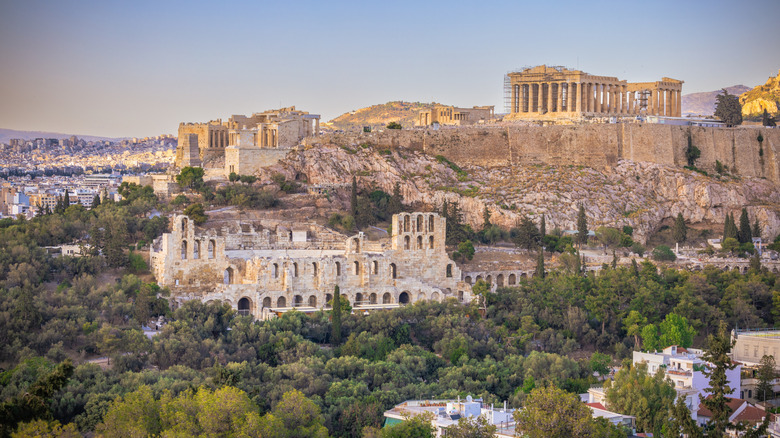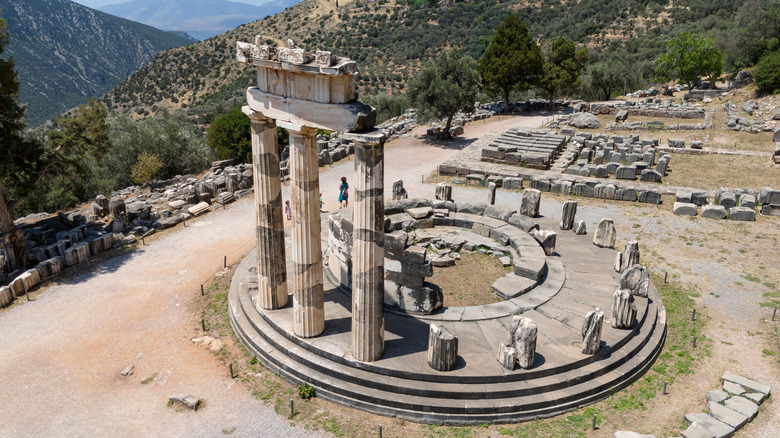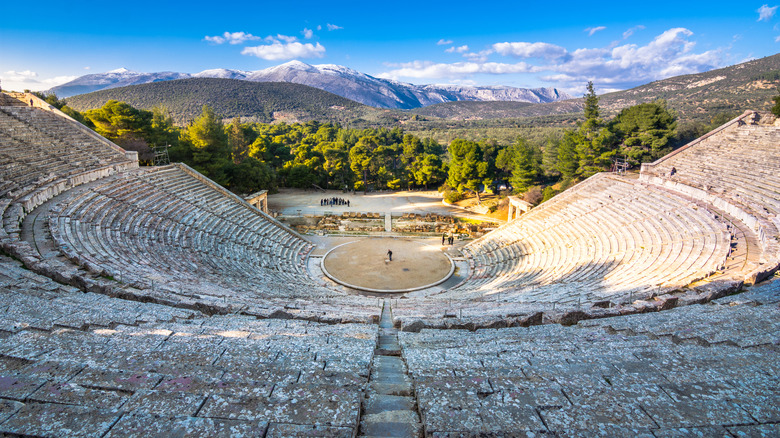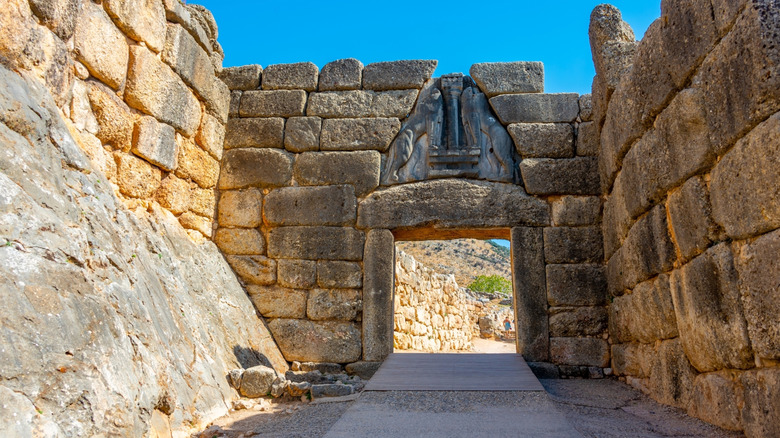Three Of Rick Steves' Recommended Destinations For Exploring Greece's Ancient Ruins
People venture to Greece for many different reasons: whether it be the delicious food, the glistening waters and white sandy beaches, or likely, the massive array of ancient ruins. In fact, according to Europe's favorite travel guru, Rick Steves, although some Greek ruins are must-sees (like the Acropolis and Agora), in his blog piece titled "Exploring Greece's Ancient Past, "ancient ruins can quickly go from magnificent to mind-numbing. Just because something dates from BC doesn't mean it has to be seen." Meaning that in order to save yourself from historical overload, it's important to be selective when it comes to choosing which sites to see.
For Steves, he has three in particular that he can't go to Greece without seeing — Delphi, Epidavros, and Mycenae. He proceeds to say that "All are within three hours of Athens — and all are well worth the trek." So, what sets these three apart from the rest? Well, as Steves says, "Each offers a unique opportunity to delve into ancient life and explore Greece's rich history." However, these sites are not only for history buffs to enjoy. They also provide visitors with the chance to experience the magnificence of how Greece once was, and connect with its natural and architectural beauty.
Delphi is a place that stirs the imagination with its mystical mountaintop setting and its role as the spiritual heartbeat of the ancient world. Epidaurus pairs healing and art, where medicine and drama met under the open sky in a theater so perfectly designed it still hosts performances today. Lastly, Mycenae is an ancient world that plunges you deep into the past, into the mythic age of Homeric heroes, walls built by cyclopes, and magnificent tombs, long before democracy and philosophy came into play.
Visit Delphi, the site of gods, philosophers and kings
Set high atop the hills of Mount Parnassus and framed by a beautiful panorama of olive groves rolling toward the Gulf of Corinth, sits a place that was once, according to Steves "one of the most important sights in the ancient world." Now a UNESCO World Heritage Site, Delphi was once revered by the ancient Greeks as the center of the world, and it drew kings, philosophers, and warriors seeking wisdom from the gods. According to Steves, "by the sixth century BC, Delphi had become so influential that no great leader would make a major decision without first sending emissaries to consult the oracle." Today, travelers come not to consult the Oracle, but to revel in the history of one of the world's oldest cities, and to imagine a time in which you could come seek advice from the gods.
Steves suggests first paying a visit to the site and then the museum, so that "you can more easily imagine the original context of (its) items". The archeological site includes the Temple of Apollo, which is the centerpiece of Delphi's ancient ruins. Begin your walk at the Sacred Way, the path once lined with offerings to the gods from grateful pilgrims.
As you ascend the path (there is a bit of a climb, unfortunately), you'll pass the Athenian Treasury, a beautifully restored structure that once held lavish gifts for the gods. Further along, you'll come across the magnificent Temple of Apollo, where the famed Oracle once sat. Pythia, the high priestess, would deliver cryptic prophecies believed to be divinely inspired by the god Apollo. Don't miss a visit to the Ancient Theatre, or the stadium where the Pythian Games, "second only to the Olympics in importance," took place every four years.
Head to Epidaurus to experience culture and science
Next, Steves suggests heading to Nafplio, a place he states has his vote for "the most charming town in Greece." Steves recommends using this town as a home base in order to go and explore Epidaurus, one of Greece's most sacred and serene archaeological treasures. It's not the scale of the ruins that leaves travelers in awe, but the perfect remains of the Ancient Theatre of Epidaurus, hailed as the finest surviving Greek theater in the world. According to Steves, "The highlight of Epidaurus is (this theater), which provided entertainment for those who made the pilgrimage here." Every summer, the Athens & Epidaurus Festival brings ancient tragedies and modern performances to this very stage, continuing a tradition that's more than two millennia old.
But Epidaurus is more than just its beautiful amphitheater. In ancient times, it served as one of the most important healing centers in the Mediterranean world, and according to Steves, "was a place of miraculous cures, where the sick came to be treated by doctor-priests doing the work of Asklepios, the Greek god of medicine."
The Sanctuary of Asclepius is highly regarded for its history of medicinal cures and is recognized as the world's earliest organized sanatorium. Here, art and science, religion and nature, performance and medicine were all intertwined in a single harmonious vision of wellness and worship. Also, every five years, a festival called Asclepius was held, in which athletic and musical competitions took place. Today, visitors are drawn to Epidaurus for its blend of ancient spirituality, natural beauty, and the chance to sit in a theater that has echoed with voices for over two thousand years.
Explore the magnificent ruins of Mycenae
Located not far from Nafplio sits the final of the three ancient sites: Mycenae. According to Steves, it's the "oldest sight you'll see in this land dotted by so many ruins". While sites like the Acropolis reflect the classical glory of ancient Athens, Mycenae takes visitors back to the Bronze Age, offering a glimpse into the foundations of Greek civilization. According to myth, this was once the seat of King Agamemnon, the commander of the Greeks at Troy and one of the most iconic figures in Homer's "Iliad." However, beyond legends, the site represents the heart of Mycenaean civilization, which flourished from approximately 1450 to 1200 BC.
As you approach the ancient site, Steves comments that "you may first notice Mycenae's majestic setting of mountains, valleys, and the distant sea. According to Steves, its location was chosen "not for its scenery but its strategic advantages.... though just scant ruins remain today, the city's mighty Lion Gate entrance is still awe-inspiring." Just inside the gate lies Grave Circle A, where six royal shaft graves were uncovered, containing gold masks (like the death Mask of Agamemnon), weapons, jewelry, and ceremonial findings. Further up the hill is the location of the once grand Palace of Mycenae.
The palace once stood at the heart of the citadel. Though only its foundations remain, you can imagine it in all its glory. Beyond the palace, you will find the Royal Tombs, the Tomb of Aegisthus, and the Tholos Tomb of Clytemnestra, each showcasing impressive works of masonry. Further down the path lies one of the best preserved tombs of the area, said to have been the burial site of Atreus, the father of Agamemnon. Lastly, pay a visit to the museum, where you'll discover many excavated items from the grounds.



